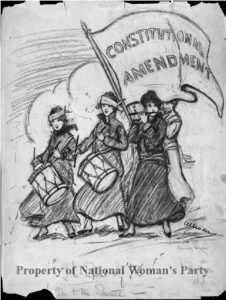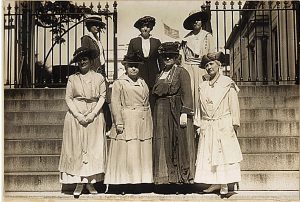Nina Allender Political Cartoon, 1915

This source is a political cartoon that was drawn by Nina Allender in January of 1915. Allender was a political cartoonist for the National Women’s Party; an organization that allowed for suffragettes to mobilize and protest across the country. This cartoon was to be published in The Suffragist, the original newspaper for the NWP, which was directed at an audience of feminists in the late 1800’s and early 1900’s. This cartoon was located on the National Women’s Party Archival database. Allender’s work is an image of four suffragettes marching on a hill, holding a flag reading “constitutional amendment.” The women are blowing horns and playing drums; the image is a representation of the spirit and dedication of the suffragettes. Women in this time period would march, strike, and do whatever was necessary to achieve their goals. This cartoon, created by a woman, shows how art was used to express achievement and mindsets. This reflects this project’s theme of how some women, struggling in a time of diversity to achieve the right to vote, turned to art to express their progress and hopes for the future.
NAWSA Photograph- Suffragette Fashion, 1917

This source is a photograph of the National American Woman Suffrage Association, taken by George Harri and Martha Ewing in 1917. The photograph was taken to document these women going to the White House to meet with President Wilson. The NAWSA was the merging organization of the two major suffrage organizations: The National Woman Suffrage Association and the American Woman Suffrage Association; these organizations merged to work together to achieve women’s suffrage. This photograph is important because it shows the clothing of suffragettes. These women would wear white to represent purity, purple to represent loyalty, and gold to represent sunflowers- the state flower of Kansas. The most important color was white, which was how suffragettes would distinguish themselves in this time. This photograph is reflective of the project overall because it exemplifies how women who were involved in the movement were able to use fashion to make a statement and to distinguish themselves. Fashion has historically been a way to make a statement and this is a prime example. This source was located on the National Archives catalog, and the purpose was to document.
Gertrude ‘Ma’ Rainey song, “Prove It On Me Blues,” 1928
This source is a YouTube video from the TeachRock website of a song by Gertrude “Ma” Rainey, called “Prove It On Me Blues,” which was released in 1928. Ma Rainey was a prominent blues singer in the 1920’s, frequently called “the mother of the blues.” This song, created for the purpose of entertainment, is about the singer’s attempt to tease the audience by hinting that she is a lesbian, but countering that no one can prove it. The song mentions how Rainey does not like men, and how she does not particularly care if anyone knows she is gay, but how they must prove it. In addition, the song references her dressing in butch clothing. Both ideas are very ahead of their time, especially for being talked about by a black woman. Black women faced the traumas of the Jim Crow era in the 1920’s and the constant threats of racial violence, in addition to having few rights since women during this time were second class citizens. This source is a prime example for this project of how women of color would use art to express their pain and struggles. Rainey is turning her sexuality, something that she would have to hide for the concern of her safety during this time, into a light-hearted song.
